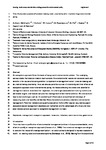A step-wise process of decision-making under uncertainty when implementing environmental policy
| dc.contributor.author | Knights, Antony | |
| dc.contributor.author | Culhane, Fiona | |
| dc.contributor.author | Hussain, SS | |
| dc.contributor.author | Papadopoulou, KN | |
| dc.contributor.author | Piet, GJ | |
| dc.contributor.author | Raakær, J | |
| dc.contributor.author | Rogers, SI | |
| dc.contributor.author | Robinson, LA | |
| dc.date.accessioned | 2015-07-02T07:36:05Z | |
| dc.date.available | 2015-07-02T07:36:05Z | |
| dc.date.issued | 2014 | |
| dc.identifier.issn | 1462-9011 | |
| dc.identifier.issn | 1873-6416 | |
| dc.identifier.uri | http://hdl.handle.net/10026.1/3401 | |
| dc.description.abstract |
An ecosystem approach forms the basis of many recent environmental policies. The underlying concept states that decision-makers must consider the environmental, social and economic costs and benefits in the course of deciding whether to implement a management action. Decision-making can be undermined by uncertainty. Here, we discuss potential sources of uncertainty and their effect on an ecosystem approach-driven environmental policy, the factors affecting the choice and potential for management actions to achieve their objectives, the challenges associated with setting realistic and achievable targets, and how we can prioritise management of detrimental activities. We also consider how human challenges such as the availability of infrastructure and political will and ways of measuring costs and benefits and Member State interactions could also undermine environmental management. Potential limitations along with areas where further effort may be required to support ecosystem-based management objectives are highlighted and the advantages of a structured step-wise interdisciplinary approach to ecosystem management is shown. © 2014 Elsevier Ltd. | |
| dc.format.extent | 56-64 | |
| dc.language | en | |
| dc.language.iso | en | |
| dc.publisher | Elsevier | |
| dc.subject | management | |
| dc.subject | ecosystem approach | |
| dc.subject | measures | |
| dc.subject | indicators | |
| dc.subject | socio-economics | |
| dc.subject | governance | |
| dc.title | A step-wise process of decision-making under uncertainty when implementing environmental policy | |
| dc.type | journal-article | |
| dc.type | Article | |
| plymouth.author-url | https://www.webofscience.com/api/gateway?GWVersion=2&SrcApp=PARTNER_APP&SrcAuth=LinksAMR&KeyUT=WOS:000336948800006&DestLinkType=FullRecord&DestApp=ALL_WOS&UsrCustomerID=11bb513d99f797142bcfeffcc58ea008 | |
| plymouth.volume | 39 | |
| plymouth.publication-status | Published | |
| plymouth.journal | Environmental Science and Policy | |
| dc.identifier.doi | 10.1016/j.envsci.2014.02.010 | |
| plymouth.organisational-group | /Plymouth | |
| plymouth.organisational-group | /Plymouth/Faculty of Science and Engineering | |
| plymouth.organisational-group | /Plymouth/Faculty of Science and Engineering/School of Biological and Marine Sciences | |
| plymouth.organisational-group | /Plymouth/REF 2021 Researchers by UoA | |
| plymouth.organisational-group | /Plymouth/REF 2021 Researchers by UoA/UoA07 Earth Systems and Environmental Sciences | |
| plymouth.organisational-group | /Plymouth/Users by role | |
| plymouth.organisational-group | /Plymouth/Users by role/Academics | |
| plymouth.organisational-group | /Plymouth/Users by role/Researchers in ResearchFish submission | |
| dc.identifier.eissn | 1873-6416 | |
| dc.rights.embargoperiod | Not known | |
| rioxxterms.versionofrecord | 10.1016/j.envsci.2014.02.010 | |
| rioxxterms.licenseref.uri | http://www.rioxx.net/licenses/all-rights-reserved | |
| rioxxterms.type | Journal Article/Review |


